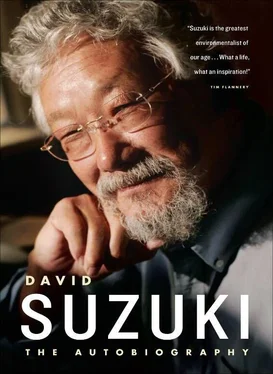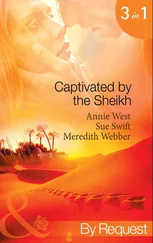If 1988 was the peak of public concern, interest continued to be high enough in 1991 to make the Earth Summit a highly anticipated event. It would be the largest gathering of heads of state in history, but I was skeptical that such a huge meeting would accomplish much. My daughter, Severn, had other ideas.
When we had returned from our trip to the Amazon in 1989, Severn had been so upset after seeing the rain forest under assault by farmers and gold miners that she had started a club made up of her grade 5 friends who shared her concern about forests. They would gather at our house to have tea and talk about what they might do. They called their club the Environmental Children's Organization (ECO) and soon were giving talks at their school and then at other schools as word of their existence spread. They began to make little salamanders and earrings out of Fimo clay and sold them to raise money.
Somehow Severn heard about the Earth Summit and asked whether Tara and I were going. I answered that we weren't and asked why she was curious. “Because I think all those grown-ups are going to meet and make decisions and they're not even going to think about us kids,” came the answer. “I think ECO should go to remind them to think about us.”
Tara and I had been involved in a number of international issues, but we had not worked with international organizations such as the United Nations, around whose official Conference on Environment and Development the broader Earth Summit had evolved. Without even reflecting on Severn's idea, I rejected it: “Sweetheart, it's going to be a huge circus with lots of people. Rio will be hot and polluted. Besides, it will cost a lot of money.” Then I promptly forgot about Sev's hope.
That summer, we had a visit from Doug Tompkins, an American who had started the clothing company Esprit with his wife, Susie Russell. When the marriage broke up, Susie bought him out and left him with a considerable chunk of money, reputed to be in the hundreds of millions. Flying his own plane, Doug travels the world looking for opportunities to invest in groups fighting to protect large areas of wilderness, and he personally buys large tracts of land to protect.
Somehow he had heard about Tara and me and the newly formed David Suzuki Foundation, so he flew to British Columbia with deep ecologist Bill Duvall and visited us at our cottage on Quadra Island for two days. During that time, unknown to Tara and me, Severn told Doug about her idea of taking ECO to Rio the following year. He was more enthusiastic than we had been and told her, “That's a good idea. Write to me about it.” She did, and one day a couple of months later, she said, “Hey, Dad, look,” and held up a check for US$1,000 from Doug Tompkins.
I was astonished. I was also pleased with her initiative in writing on her own, and for the first time, I reflected seriously about her idea; I realized she could be on to something. I talked it over with Tara, and we decided it might be worth going to the Earth Summit if children could call attention to the long-term implications of what was being decided by grown-ups. So we went back to Sev and told her we realized she had a good idea and that we would support her by matching every dollar ECO could raise. That meant she already had $2,000.
Severn and Sarika and the other ECO girls plunged into projects to raise money, gathering and selling secondhand books, creating and selling their Fimo salamanders, and baking cookies. But all that brought in only small change. Jeff Gibbs of the Environmental Youth Alliance, that young man who had cut his teeth in environmental activism in high school, took ECO under his wing and helped the girls publish a series of ECO newspapers with articles the youngsters wrote about the environment. Jeff also suggested a major fund-raising event at which the kids could tell people what they wanted to do. It was scheduled for March 17, 1992. With a great deal of help from Jeff, Tara, and others, the girls booked the Vancouver Planetarium, made and distributed posters, and called members of the press and urged them to cover the event. Parents, relatives, and friends, of course, were recruited to attend.
The event was packed. Tara had the inspiration of including a blank check in the package of material left on every seat, thereby removing the excuse “I didn't bring a check with me.” The girls had all prepared talks to go along with a slide show about the environment. They said they wanted to go to Rio to be a conscience to adults, and they asked the audience to help them. It was a powerful presentation because the girls spoke from their hearts, and their very innocence and naïveté touched a chord. During the break, an older man leaped onto the stage, held up five checks for $200 each, and announced he was so inspired that he would donate them if others would match them. People began to fill in the blank checks. Dad anted up $200.
The girls ended up with over $4,700 from that one event, which they had hoped might raise $1,000. Raffi Cavoukian, the well-known children's troubadour, had moved to Vancouver; he had become very interested in environmental issues and wrote a check for another $4,000. Somehow a Toronto philanthropist who supports women's issues heard about the girls and sent another check for $4,000.
In all, the girls had raised more than $13,000, which Tara and I had to match — enough money to send five ECO members (including, of course, Severn and Sarika) and three parents (Tara, me, and Patricia Hernandez, the Spanish-speaking mother of one of the other girls) to Rio.
Although I was now planning to go to the summit, I remained skeptical about what the meeting itself would achieve. In December 1991, I interviewed conference coordinator Maurice Strong for The Nature of Things with David Suzuki and expressed my skepticism. He was irrepressibly optimistic, saying the conference couldn't fail because the future of the planet was at stake. When I pressed him, he responded, “If it does fail, it must not be allowed to be a quiet failure and recede unnoticed from memory.”
The Earth Summit was heralded by Carlo Ripa di Meana, environment commissioner of the European Union, as a chance “to make decisions, obtain precise and concrete commitments to counteract tendencies that are endangering life on the planet.” But in order to ensure U.S. president George Bush's participation, the proposed Treaty on Climate was watered down from a target of a significant reduction in greenhouse gas emissions to merely “stabilizing 1990 levels of emissions by 2000.” This caused Ripa di Meana to boycott the meeting because, he said, “by opting for hypocrisy, we will not just fail to save the Earth, but we will fail you.” So things were not looking good.
Once it was known that Tara and I were going to Rio, we were asked to become involved in some of the deliberations leading up to the event. For years, hundreds of groups and thousands of people had been attending Prepcom (Preparatory Committee) meetings in different countries to draft documents to be presented to and signed by leaders at Rio. The signings would be merely formalities and photo ops, because all the wording would have been worked out beforehand.
To persuade all countries to sign on, the wording in the documents had to be fine-tuned to avoid offending signatories — oops, can't talk about overpopulation to the developing countries, don't mention family planning lest it scare off the Catholic countries, mustn't raise the issue of hyperconsumption in the industrialized countries. Documents on forests, water, air, and so on were drafted, passed through many hands, edited and reedited, rewritten many times.
By the time I was called in to one of the meetings in Vancouver to look at a forestry document, people were spending a great deal of time arguing over whether there should be a hyphen here or a comma there or whether it should be “the” or “a.” Maybe I'm being unfair, because I went to only one meeting and abandoned further attendance as a waste of my time. I know lots of people who invested huge amounts of energy in the process, and thank goodness there were people willing to do it.
Читать дальше


![David Jagusson - Devot & Anal [Hardcore BDSM]](/books/485905/david-jagusson-devot-anal-hardcore-bdsm-thumb.webp)









